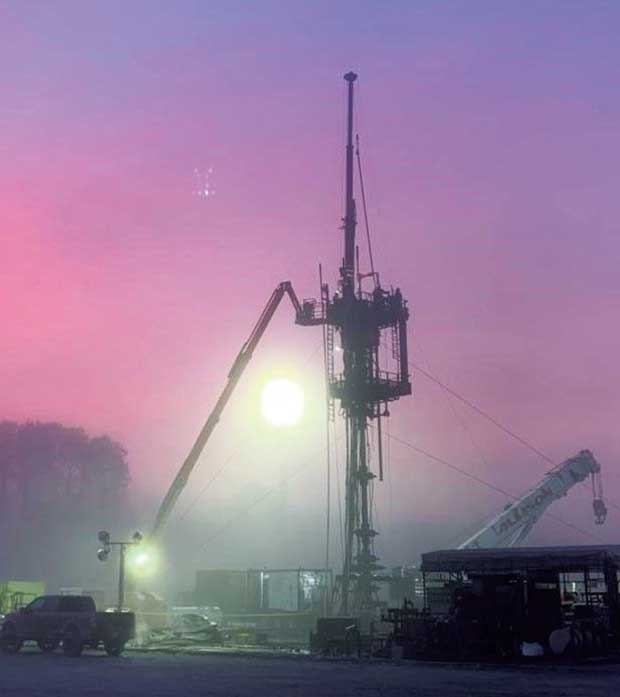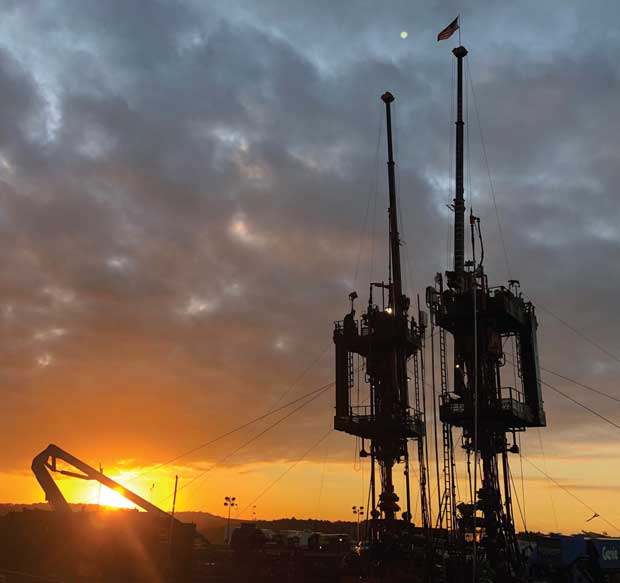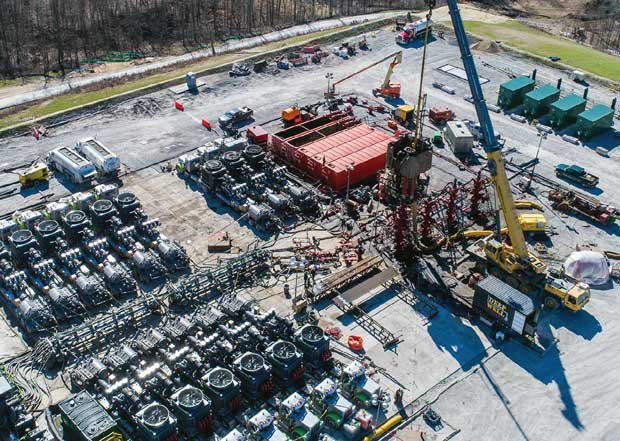
Marcellus/Utica
Next-Generation HCUs Drill Out Plugs In Record Extended-Reach Wells
By Tim Beims
ZELIENOPLE, PA.–In the spring of 2016, the Purple Hayes No. 1H in Ohio’s Utica Shale play made history as the longest lateral ever drilled on shore in the United States. It was a “moonshot” moment in Appalachian Basin horizontal development, opening a brave new world in extended-reach architectures and establishing a number of benchmarks for drilling and completion operations.
But after the drilling rig and frac spread moved off location, a specially designed hydraulic completion unit (HCU) moved on to perform an unheralded but integral part of the wellbore construction process that was every bit as impressive: milling out 123 composite frac plugs spaced every 150 feet apart along the 18,544-foot lateral and running the production tubing in a post-frac pressurized downhole environment.
The HCU used on Purple Hayes was the first of its class. It incorporated a number of purpose-engineered components to enhance the rotary and pressure control capabilities of the integrated rig/snubbing unit, allowing it to safely achieve a plug-back total depth of 26,868 feet, according to Matt Tourigny, vice president of marketing and innovation at Deep Well Services, a division of Sun Energy Services LLC. “We began developing a next-generation HCU solution in response to the job requirements on Purple Hayes,” he says. “Frac plug drill-out operations had never been attempted at that kind of total measured depth. It was five miles from the surface to the toe, and the lateral was more than 3.5 miles long.”
Jump forward to 2020, and the same base HCU design engineered for Appalachia’s first “super lateral” once again is helping operators accomplish the incredible, pushing lateral lengths and total measured depths beyond those achieved on Purple Hayes.
“In the second and third quarters alone, three wells set new records for lateral length and MD,” Tourigny observes. “No basin in the world is drilling and completing long laterals like Appalachia. Five years ago, 6,000 feet was a long lateral. Today, 20,000 feet is a long lateral, and 15,000 feet has become routine.”
As bleak as Q2 and Q3 were for oil and gas activity–the Marcellus and Utica notwithstanding–it was during those dark days that three different operators flashed the undeniable technical brilliance of an Appalachian industry that is redefining what’s possible in extended-reach operations.
First, an independent completed what at the time was the longest horizontal ever drilled in the Marcellus: 19,625 feet of perforated lateral and 27,692 feet of total MD. However, that record stood for only a couple months. As summer turned to fall, another independent brought in a Marcellus well with a 19,858-foot perforated lateral and total MD of 27,423 feet. Both wells are in Southwest Pennsylvania.
Meanwhile, across the state line in Ohio’s Utica Shale play, yet another operator established a new North American land record for total MD with a 30,746-foot horizontal. Also completed in Q3, that well had a 19,883-foot perforated lateral section.
On each project, an HCU was called on to perform the final critical operational phase before turning the wells over to production, Tourigny reports. And the units did so with astonishing efficiency–drilling out 100-plus frac plugs in single bit runs with zero short trips required to sweep the hole–under live well conditions with pressure and friction progressively intensifying as the milling assembly moved farther out into the laterals with each successive plug.
“In all three of these record-setting wells, the HCUs drilled out the frac plugs using one bit in a single trip and ran production pipe in the required wells exactly as planned without encountering any operational issues or recording any health, safety, quality and environment incidents,” he summarizes.
Engineering Challenges
Including the three latest extended-reach trendsetters, Marcellus and Utica operators now have drilled and completed a total of eight laterals in the 20,000-foot range and four wells with total MDs of 30,000-plus feet, setting one record after another in the process. Deep Well Services’ HCUs have performed the drill-outs successfully under live pressurized conditions on all those wells.
“The performance of the HCUs validates the design of the equipment components and the operational procedures developed initially for Purple Hayes and optimized with each new super lateral,” Tourigny relates. “The right equipment and procedures not only ensure that total depth can be reached safely and quickly on 30,000-plus foot MD wells and 20,000-plus foot laterals, but that it can be done in one trip using one bit to save time and cost.”
The engineering challenges for operating under pressures as great as 8,000-9,000 psi at extreme depths range from designing drill strings with appropriate torsional and tensile strength capacities to maintaining circulation and limiting downhole debris and sand accumulation to prevent pipe sticking, not to mention controlling pressures at surface. To develop a highly reliable system to handle all the challenges, Tourigny says Deep Well Services started by assessing the state of the art in hydraulic completion capabilities as it existed in 2016.
As nightmarish as Q2 and Q3 were for oil and gas activity in U.S. shale basins–the Marcellus and Utica notwithstanding–it was during those dark days that Northeast operators flashed the undeniable technical brilliance of an Appalachian industry that is redefining what’s possible in extended-reach operations with three record-setting wells in Pennsylvania and Ohio.
“We stepped back to see where the technology was at that time and identify areas where we had to adopt a ‘green-field’ mentality of redesigning equipment to make sure we could check all the boxes on the entire operation of drilling out plugs and running production pipe in extended laterals,” he states. “From there, we started building the individual components and processes.”
The first box is having sufficient rig horsepower for the required hook loads, along with a drill string that is sufficiently robust to withstand punishing weight, tensile, torque and friction. “Pulling off bottom at 30,000 feet MD in a well with higher dogleg severity sections really pushes the physical capabilities of the rig and pipe,” he notes. “You also have to understand friction, fluid dynamics and pressure differentials while circulating and drilling out frac plugs in extended lateral wellbores.”
The HCUs are designed with a four-post jack assembly and a Consolidated Rig Works rotary table with a “timed” automated drilling system to continuously optimize weight on bit (WOB) and rotational speeds during milling to reduce bottom-hole assembly failures and maintain positive penetration rates. The drill string design varies by well, but often uses a split-string approach with different sizes and/or weights of jointed pipe in the lateral, curve and vertical sections. The BHA consists of a bit and “float” subs, which Tourigny says are essentially check valves to allow one-way flow through the work string and prevent pressurized fluid from entering the system.
One-Trip Operations
The economic rationale behind extended-reach wells is predicated on lowering the total cost per completed foot of lateral. To that end, Tourigny says from the very beginning a key driver in the development of the HCUs has been enabling safe and reliable one-bit, one-trip operations.
“In the current commodity price cycle, all operators are focused on cost control. Their authorizations for expenditures are under such a microscope that spending one or two days tripping out of the hole to change out a failed bit would run up AFE and materially impact well cost,” he remarks. “The jack assembly, drill string, rotary table, BHA, automated WOB and ROP, torque and drag modeling, friction analysis, fluid system, blowout preventers . . . each component has to be perfected in order to successfully TD these ‘monster’ laterals with one bit in one trip.”
The HCU jacks’ sensitivity enables precise WOB to prolong life and increase milling efficiencies from heel to toe while circulating plug and sand debris. Rotating speeds of at least 50 rpm have been maintained in all eight 20,000-foot laterals completed to date, according to Tourigny. “In the vast majority of extended laterals greater than 19,000 feet, the HCUs have achieved total drill-out times in fewer hours than the number of plugs installed,” he reports.
Marcellus and Utica operators have drilled and completed a total of eight laterals in the 20,000-foot range and four wells with total measured depths of 30,000-plus feet, setting one record after another in the process. Next-generation HCUs have performed the frac plug drill-outs under live pressurized conditions on all of those wells, enabling one-bit, one-trip operations capable of drilling out more than one plug per hour on average in extended laterals with 125 or more plugs.
For example, in one recent 30,000-foot MD well, Tourigny points out, 144 plugs were drilled out in a total of 125 hours, including circulation time. In another with 28,800-foot total MD and a 20,780-foot lateral, 126 plugs were drilled out in 94 hours, averaging 1.34 plugs per hour. Including rigging up and rigging down, the total time on the well to drill out plugs and run the production string was 130.25 hours from start to finish.
But it’s not only a matter of efficiency and speed. With HCUs operating in a live post-frac environment, safety is priority one. The guiding philosophy underlying Deep Well Services’ scientific approach to engineering the equipment and best practices for long-lateral milling and snubbing is mitigating downhole and surface risk by planning for potential “What if?” scenarios, Tourigny relates.
“You have to work through any possible curveballs, and how they may affect different parts of the operation to understand all the possible issues and prepare contingencies to manage them,” he goes on. “Take the float subs for example. They consist of springs, flappers and O-ring seals. They are very simple, but they are mechanical devices, which means they can fail. We plan for such a failure to make sure the equipment and procedures are in place to maintain proper well control at all times.”
It is common on super laterals to mill plugs with 6,000 psi or more pressure at surface. HCU operations have dual blowout preventor stacks. The primary control is typically a 15,000-psi BOP with blind rams and shears that is run off a separate accumulator and power source, Tourigny details. Secondary control is provided by a segregated BOP stack on the snubbing unit that is identical to the primary system except that the rams' fronts are coated in Teflon to strip while maintaining a fail-proof seal.
Proactive Approach
The newest component in the HCU system for long laterals is a patented data acquisition and analytics tool that utilizes more than a dozen parameters to customize drill-out job designs and optimize efficiencies in real time. Snubwell® technology creates a dataset to aid in designing operations on new wells, model and predict results, and monitor operations in real time to compare actual results with modeled results from historical data, Tourigny says.
“Basically, it captures the data acquired on all the super laterals we have TD’d so far to enable us to apply lessons learned on past wells to new wells,” he offers. “That is very powerful in terms of providing insights to understand exactly what is going on down hole at any point so crews can be proactive and take corrective actions to ensure that key performance indicators are met at every phase.”
As the super lateral dataset expands with each new well, it creates more cross-reference points to evaluate real-time data feeds. “If, for example, real-time data shows higher rotary torque than the prejob torque and drag modeling predicted, we can trend back through the dataset to see if other wells experienced similar torque responses, why, and what was done,” Tourigny holds, adding that the combination of real-time and historical data for analysis before, during and after the job is critical to continuously improving performance, eliminating potential problems, and ultimately, saving the operator money.
Having high-quality data also optimizes equipment designs. Traditionally, coiled tubing drill-outs in longer laterals required BHA configurations with agitators (vibrators) and dump subs to increase annular velocities for proper circulation at greater depths, he notes. “Analyzing the dataset indicated that agitators and dump subs were not needed with HCUs and joined pipe,” Tourigny states. “With data in hand, we sat down with our tool company partners and operators and designed simple BHAs that reduce cost and risk on long laterals. HCU core drilling BHAs consist of a bit, a motor and two sets of floats. That’s it.”
Drill String Design
All eight super laterals completed so far have used conventional composite plugs rather than dissolvable plugs to avoid the risk of dissolvable materials not fully degrading and leaving well flow obstructions in the casing, Tourigny indicates. He adds that the mill-out bit of choice on Appalachian Basin super laterals is a traditional three-cone rock bit, typically a Varel SlipStream™ hybrid roller cone bit with steel teeth and tungsten carbide insert gauges designed especially for the composite, cast iron and ceramic plug materials.
The four-post snubbing units’ ability to automatically maintain optimal WOB, ROP and other drilling parameters extends bit and motor performance by staying within the “sweet spots” of their intended designs, Tourigny says. “When we pull the bits after reaching TD on 20,000-foot laterals, the cones and bearings are generally in good shape,” he reports. “Maximizing bit and downhole motor life are essential to drilling 100 or more plugs in a single run.”
Drill strings are customized for each application based on expected torque, drag, friction, tortuosity and other downhole factors, but typically use 2 7⁄8-inch outside diameter jointed pipe. Although some strings have contained segments of 2 3⁄8-inch tubing in the lateral to reduce friction, they often consist of 2 7⁄8-inch pipe tapered by weight rather than outside diameter, explains Tourigny.
HCUs are highly versatile and adaptable, capable of conducting numerous operations under live well conditions that traditionally have required multiple service rigs and crews, including running tubing-conveyed perforating guns. Shown here is an extended-reach well site during completion operations, with a ProFrac spread in place on location and an HCU rigged up over the well. Like drilling rigs and HCUs, fracturing fleets also are evolving to meet the unique challenges of high-stage count, long-lateral Marcellus and Utica wells.
“The string might all be 2 7⁄8 OD to maximize annular velocity, but the bottom portion nearest the toe might be traditional 9.7 pounds/foot, while the portion going through the build/heel sections and through to surface is heavier-weight drill pipe to maximize torsional and tensile strengths,” he details. “As the bit moves down a 20,000-foot lateral, the downhole dynamics can start behaving very differently than they do nearer the heel.”
Unlike with CT drill-outs, HCUs do not require periodic sweeps to pull the BHA partly back up the hole to flush fluid and debris back to surface, Tourigny adds. The HCU’s 10,000 foot-pound rotary table can rotate the drill string at speeds as fast as 120 rpm under 10,000 psi of true working pressure while flowing up to six barrels of fluid a minute to achieve adequate annular velocities to keep the lateral swept clean all the way at TD. Drill-out fluids are typically slickwater or filtered recycled produced water.
“We have never had to trip partially back out of the hole to do a sweep, and have always maintained positive forward momentum and high ROP on all the super laterals,” he avers. “That eliminates nonproductive time and allows plugs to be drilled out at speeds averaging faster than one per hour from plug to plug, even in the toe.”
Versatile And Adaptable
Once the bit reaches TD, the workstring is tripped out and slick external upset end production tubing can be run back into the well. In some cases, an isolation packer must be installed, which can be completed through the HCU, although most operators choose to use electric line. E-line is rigged on top of the HCU to run the packer down the hole. According to Tourigny, it only takes an hour to disassemble the stationary slips and jack plate in order to be fully ready to bolt the e-line unit onto the HCU. Then, once the packer is set and tested, e-line is removed and the HCU is ready to sting into the packer and run production tubing, an electric submersible pump, gas lift mandrels, or any other necessary bottom-hole equipment.
“These units are like Swiss Army knives,” he compares. “They are versatile and adaptable, and can do multiple wellsite operations that traditionally have required multiple rigs and service crews. That means a smaller footprint, fewer people and less traffic.”
A case in point is a well completed in 2019 with a 19,000-plus foot lateral (at the time a record length, but it has since been overtaken by multiple wells). Tourigny says the HCU was on location on four separate occasions, starting with rigging up right after the drilling rig had left to run tubing-conveyed perforating guns into the toe ahead of the first frac stage. It then moved off and the frac spread moved on. However, during subsequent plug-and-perf operations, the HCU was called back to the well to fish a perforating gun string.
“With all the frac equipment on site, the HCU rigged up and retrieved the gun string with minimal frac spread disruption. The HCU then moved off again until fracturing was finished,” he recalls. “The third trip was to drill out the plugs. The operator wanted to flow the well through casing for a while to conduct tests, so the unit was moved off again after drill-outs and then came back to the well a few months later for a fourth time to run production tubing.”
Tourigny contends that HCU capabilitie already have evolved to an advanced enough stage that the technology comfortably can accommodate still greater technical requirements should Appalachian operators decide to push the boundaries of extended-reach even farther than the record wells drilled and completed last summer and fall. However, he suggests that 30,000-foot MDs and 20,000-foot laterals may approach practical constraints imposed by lease boundary dimensions and economic drivers.
At some point, he adds, lateral extension starts seeing diminishing returns that impact the cost benefit per completed foot. “I am not sure exactly where that point is or how much need operators will have to extend lateral lengths beyond 20,000 feet, but should they decide to go longer, the frac plug drill-out operation will not be what limits getting those wells drilled, completed and on production,” he concludes.
For other great articles about exploration, drilling, completions and production, subscribe to The American Oil & Gas Reporter and bookmark www.aogr.com.


















